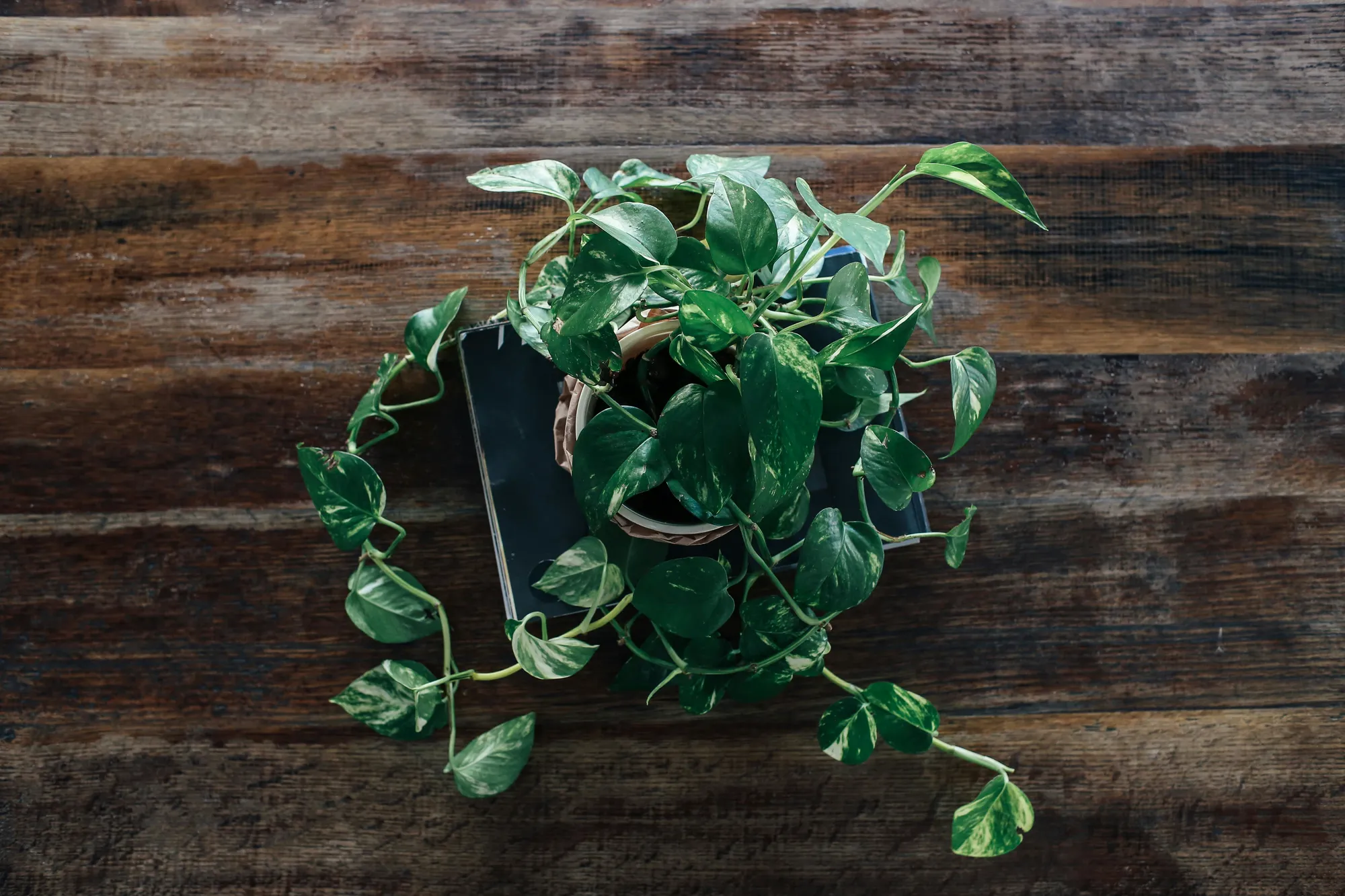Epipremnum aureum (Pothos / Devil’s Ivy): care, watering and propagation

🌿 Quick Summary:
- ☀️ Bright, indirect light but tolerates low light.
- 💧 Water when the top 2–3 cm (1 in) of soil are dry.
- 🌱 Fast-growing and easy to propagate from cuttings.
- 🪴 Prefers loose, well-draining soil.
- 🌡️ Ideal temperature: 18–30 °C (65–86 °F).
🌿 About Epipremnum aureum
The Epipremnum aureum, commonly known as Pothos, Devil’s Ivy, or sometimes Scindapsus, is a tropical climbing vine native to Southeast Asia and the Solomon Islands.
It’s famous for its heart-shaped, variegated leaves and its ability to thrive in almost any indoor condition.
Pothos is one of the easiest and most forgiving houseplants, ideal for beginners and perfect for hanging baskets or shelves.
🌿 Botanical profile
| Feature | Details |
|---|---|
| Scientific name | Epipremnum aureum |
| Common names | Pothos, Devil’s Ivy, Scindapsus |
| Family | Araceae |
| Origin | Southeast Asia, Solomon Islands |
| Type | Evergreen tropical climbing vine |
| Mature size | 1–3 m (3–10 ft) indoors |
| Light | Bright, indirect light (tolerates low light) |
| Watering | Moderate; allow topsoil to dry |
| Temperature | 18–30 °C (65–86 °F) |
| Humidity | Medium to high |
| Toxicity | Toxic if ingested (keep away from pets and children) |
☀️ Light and placement
Pothos adapts to a wide range of light conditions — from bright, filtered light to partial shade.
It thrives best in bright, indirect light, which keeps its variegation vivid.
💡 Tip: In low light, variegated leaves may turn more green.
Too much direct sunlight can scorch the foliage.
Ideal for offices, bathrooms, or north-facing windows — just avoid dark corners for long periods.
💧 Watering and humidity
Water moderately — the Pothos prefers being on the dry side.
Allow the top 2–3 cm (1 in) of soil to dry before watering again.
- Use room-temperature water.
- Avoid waterlogging; always empty the saucer.
- Mist occasionally to maintain humidity, especially in winter.
🚫 Overwatering causes yellowing leaves and root rot.
💧 Underwatering leads to curling or drooping leaves.
💡 Pro tip: Pothos will tell you when it’s thirsty — leaves slightly droop, then perk up after watering.
🌱 Soil and repotting
Ideal mix:
- 50 % potting soil
- 30 % perlite or orchid bark
- 20 % coco coir or peat moss
This airy, well-draining substrate prevents excess moisture and supports root health.
Repot every 2 years, or when roots emerge from the drainage holes.
Choose a light pot with good drainage, one size larger than the previous.
🌾 Fertilizing
Feed every 4 weeks during the growing season (spring to early autumn) with a balanced liquid fertilizer diluted to half strength.
Skip fertilizing during winter dormancy.
🌿 Tip: Pale leaves or slow growth often mean the plant needs nutrients or brighter light.
✂️ Pruning and maintenance
Trim regularly to keep the plant full and prevent leggy growth.
Cut just above a leaf node to encourage new shoots.
Wipe leaves with a damp cloth to remove dust and enhance their natural sheen.
🪴 Aesthetic tip: Train your Pothos on a moss pole or let it trail gracefully from a shelf for a lush jungle effect.
🪴 Propagation
Pothos propagation is simple and highly rewarding.
You can root stem cuttings in water or soil.
How to propagate:
- Cut a 10–15 cm (4–6 in) stem just below a node.
- Remove lower leaves, keeping at least 2 nodes.
- Place in water or moist soil.
- Transplant once roots reach 5 cm (2 in).
💡 Tip: Keep cuttings in bright, indirect light for best results.
Roots usually form in 2–3 weeks.
🐛 Common problems and solutions
| Problem | Likely cause | Solution |
|---|---|---|
| Yellow leaves | Overwatering | Let soil dry more between waterings |
| Brown leaf edges | Low humidity | Mist regularly or use a humidifier |
| Faded variegation | Too little light | Move to a brighter spot |
| Leggy growth | Lack of pruning or light | Trim stems and increase light |
🌳 Varieties and appearance
There are many stunning cultivars of Pothos to explore:
- Golden Pothos — green leaves with golden-yellow marbling.
- Marble Queen — creamy white variegation.
- Neon Pothos — bright lime-green leaves.
- Jade Pothos — solid dark-green foliage for low light.
🌱 Combine several varieties for a vibrant, tropical display.
🍀 Symbolism and benefits
Known as a symbol of perseverance and positivity, the Pothos is said to attract luck and wealth.
It’s also one of NASA’s top air-purifying plants, removing formaldehyde, benzene, and xylene from indoor air.
🌿 Ideal for bedrooms and offices — it improves oxygen flow and mood.
🛠️ Useful accessories
Keep your Pothos thriving with:
(Affiliate links verified by Verdepedia.)
⚠️ Common mistakes
- Watering too frequently.
- Keeping the pot in standing water.
- Exposing to full sun behind glass.
- Forgetting to prune leggy stems.
🚨 Quick diagnostic guide
| Symptom | Cause |
|---|---|
| Yellow leaves | Overwatering |
| Brown tips | Dry air or low humidity |
| Pale leaves | Too little light |
| Long, thin vines | Lack of pruning or nutrients |
❓ Frequently asked questions
Q: Why are my Pothos leaves turning yellow?
A: It’s usually a sign of overwatering. Let the soil dry before the next watering.
Q: How fast does a Pothos grow?
A: In good light and warm temperatures, it can grow up to 30 cm (12 in) per month.
Q: Can I grow Pothos in water permanently?
A: Yes, but growth will be slower. Change the water weekly and add a drop of liquid fertilizer monthly.
Q: Is Pothos safe for pets?
A: No, it contains calcium oxalate crystals that can irritate the mouth if ingested by cats or dogs.
